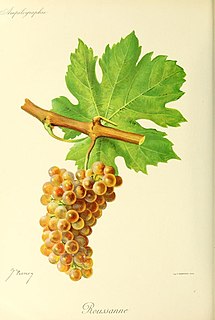
Roussanne is a white wine grape grown originally in the Rhône wine region in France, where it is often blended with Marsanne. It is the only other white variety, besides Marsanne, allowed in the northern Rhône appellations of Crozes-Hermitage AOC, Hermitage AOC and Saint-Joseph AOC. In the southern Rhône appellation of Châteauneuf-du-Pape AOC it is one of six white grapes allowed, where it may be blended into red wines. Roussanne is also planted in various wine-growing regions of the New World, such as California, Washington, Texas, South Africa and Australia as well as European regions such as Crete, Tuscany and Spain.

Marsanne is a white wine grape, most commonly found in the Northern Rhône region. It is often blended with Roussanne. In Savoie the grape is known as grosse roussette. Outside France it is also grown in Switzerland, Spain, Australia, New Zealand, Canada and the United States.
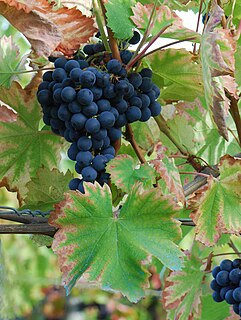
Mourvèdre is a red wine grape variety grown in many regions around the world including the Rhône and Provence regions of France, the Valencia and Jumilla and Yecla denominaciones de origen (DOs) of Spain, as well as the Balearic Islands, California and Washington and the Australian regions of South Australia and New South Wales, as well as South Africa. In addition to making red varietal wines, Mourvèdre is a prominent component in "GSM" blends. The variety is also used to make rosé and port-style fortified wines.
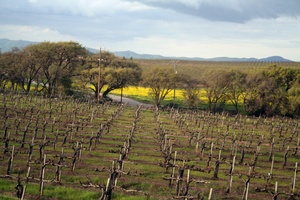
The Livermore Valley AVA is an American Viticultural Area in Alameda County, California, surrounding the city of Livermore in the Tri-Valley region. Both the AVA and the city are named after Robert Livermore, a landowner whose holdings encompassed the valley. The groundwater basin underlying the valley is the Livermore Basin, the largest sub-unit of which is the Mocho Subbasin. The Livermore Basin is one of five aquifers in the San Francisco Bay Area that supply most of the metropolitan Bay Area population. The entire Livermore Basin aquifer faces a concern over elevated total dissolved solids by the year 2020 due to an expanding human population leading to higher rates of return water flows to the aquifer containing certain salts.
DeLille Cellars is a winery in Woodinville, Washington, USA. The tasting room is located in the Hollywood District of Woodinville, at the former Redhook Brewery. DeLille Cellars specializes in wines using the Bordeaux grape varieties: Cabernet Sauvignon, Merlot, Cabernet Franc, and Petit Verdot. In 2000, DeLille won The New York TimesWine Today.com "Winery of the Year" award. It is one of Washington state's premier cult wines.

Torbreck is an Australian winery in the Barossa Valley, founded by David Powell in 1994. The winery was named one of the World's Top 100 Wine Estates by Robert Parker. The winery is named after a forest in Scotland where Powell worked as a lumberjack. The wines are made in a style emulating those of the Rhône Valley and are made from various grapes including red grapes Shiraz, Grenache and Mataró as well as white grapes Viognier, Roussanne and Marsanne.

Washington wine is a wine produced from grape varieties grown in the U.S. state of Washington. Washington ranks second in the United States in the production of wine. By 2017, the state had over 55,000 acres (220 km2) of vineyards, a harvest of 229,000 short tons (208,000 t) of grapes, and exports going to over 40 countries around the world from the 940+ wineries located in the state. While there are some viticultural activities in the cooler, wetter western half of the state, the majority (99.9%) of wine grape production takes place in the shrub-steppe eastern half. The rain shadow of the Cascade Range leaves the Columbia River Basin with around 8 inches (200 mm) of annual rain fall, making irrigation and water rights of paramount interest to the Washington wine industry. Viticulture in the state is also influenced by long sunlight hours and consistent temperatures.
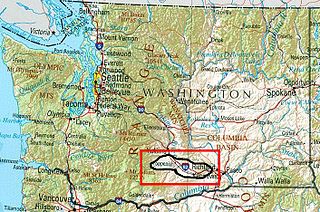
The Yakima Valley AVA was the first American Viticultural Area established within Washington state, gaining the recognition in 1983. Part of the larger Columbia Valley AVA, Yakima Valley AVA is home to more than 18,000 acres (73 km2) of vineyards, giving the area the largest concentration of wineries and vineyards in the state. The most widely planted varietals in the area are Chardonnay, Riesling, Merlot, Cabernet Sauvignon, Pinot gris, and Syrah. Nearly 40% of Washington state yearly wine production is made from Yakima Valley grapes. In addition to grapes, the Yakima Valley is also home to several fruit orchards growing apples, cherries, nectarines, peaches, pears and plums. Around the town of Zillah, there is the Zillah Fruit Loop driving tour through the area's orchards and vineyards. The area is also home to nearly 80% of the US hop production.

The Horse Heaven Hills AVA is an American Viticultural Area in southeastern Washington, and is part of the larger Columbia Valley AVA. The Horse Heaven Hills AVA borders the Yakima Valley AVA on the north and the Columbia River on the south. Elevations in this AVA range from 200 feet (61 m) above sea level in the south to 1,800 feet (549 m) above sea level at the northern boundary. Grapes planted in the south-facing slopes of the Horse Heaven Hills benefit from strong winds that arrive from the west via the Columbia Gorge, reducing the likelihood of rot and fungal diseases.

The El Dorado AVA is an American Viticultural Area located in El Dorado County, California, United States. Wine grape growers in the region produce a large diversity of varietals, notable varietals are Zinfandel, Barbera, and Syrah and there are significant plantings of Rhône varietals. Located in the foothills of the Sierra Nevada mountains, vineyards are found primarily at elevations between 600 feet (183 m) and 3,500 feet (1,067 m) above sea level and some of the best vineyards are planted above 2,000 feet (610 m) elevation. The region benefits from the cool breezes that come off the mountains and push hot air off the vines and down to the valley. The soils of the region are magma based with high levels of acidity.
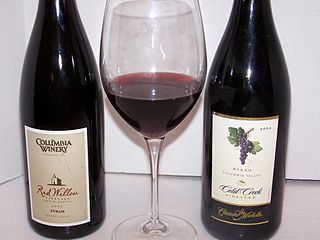
The Rhone Rangers are a group of American winemakers who promote the use of grape varieties from the Rhône Valley. They are mostly based on the West Coast, particularly California, and have created a not-for-profit organization for the promotion of wines containing at least 75% of the 22 Rhône grape varieties. The name is a pun on The Lone Ranger, and was coined by Wine Spectator to describe Randall Grahm for their 1989 April 15 issue, which featured Grahm dressed as the Lone Ranger under the title "The Rhône Ranger" (singular). The name was subsequently used for other winemakers.

David Lake was a Washington winemaker and Master of Wine. Born in England to Canadian parents, Lake started in the wine industry working for a British wholesaler. In 1975 he earned his Master of Wine certification before traveling to the United States to enroll into the enology program of University of California-Davis. In 1978 he accepted a position of enologist with the Washington winery Associated Vintners where he soon rose to the position of chief winemaker. Among Lake's accomplishments was releasing Washington's first single vineyard designated wines and making the states first Cabernet franc, Syrah and Pinot gris wines. He was the first US winemaker to hold a Master of Wine accreditation.
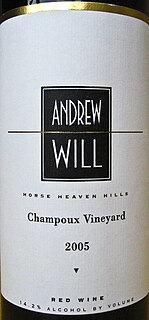
Champoux Vineyard is a grape growing estate located in the Horse Heaven Hills AVA of Washington state. Grapes grown in the vineyard have been used to produce some of the most critically acclaimed Washington wines with the name Champoux regularly being featured on vineyard designated wines. Paul Gregutt, wine writer for the Seattle Times and Wine Enthusiast, list Champoux as one of the "top ten" vineyards in the entire state. Cabernet Sauvignon grapes from Champoux vineyards were featured in the consecutive 100 point Robert Parker rated wines from Quilceda Creek Vintners for the 2002 and 2003 vintages.

Adelaida Vineyards & Winery is a family-owned and operated winery that was named after a 19th-century settlement in the mountains of west Paso Robles, California. Situated at 2,000 feet (610 m) of elevation and 14 miles (23 km) from the Pacific Ocean, the terrain of the Adelaida, California district is marked by ancient calcareous soils, diurnal temperature variations of nearly 50 °F (10 °C), and warm, dry growing seasons. Adelaida Vineyards & Winery produces Cabernet Sauvignon, Pinot noir, Syrah, Rhône blends, Zinfandel and other wines from the Paso Robles AVA.
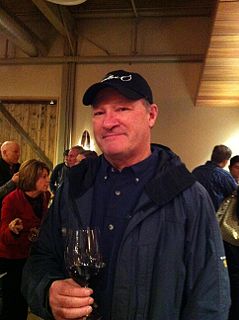
Boushey Vineyard is a grape-growing estate located in the Yakima Valley AVA, north of Grandview, Washington. Grapes grown in the vineyard have been used to produce some of the most critically acclaimed Washington wines with the name Boushey regularly being featured on vineyard designated wines. Paul Gregutt, wine writer for the Seattle Times and Wine Enthusiast, list Boushey as one of the "top ten" vineyards in the entire state. The vineyard is owned and managed by viticulturist Dick Boushey who was honored in 2002 by the Washington State Wine Commission as Washington's "Grower of the Year" and in 2007 by Wine & Spirits as their "Grower of the Year". After Red Willow Vineyard, which was planted with David Lake and Mike Sauer, Boushey was one of the first Washington wine growers to plant Syrah. Today, Boushey Vineyard is considered by wine experts such as Jon Bonné to be "One of the state's top Syrah spots" with many Washington Syrahs made from Boushey's grape receiving critical acclaim.

Chinook is a Washington winery located in the Yakima Valley AVA. Founded in 1983 by the wife and husband team of Kay Simon and Clay Mackey, Chinook was one of the pioneering wineries that established Prosser, Washington as a major wine-producing region in Washington state. Kay Simon, who began her career after graduating in 1976 from University of California-Davis in California's San Joaquin Valley and at Chateau Ste. Michelle, was one of the first female winemaker in Washington State. Chinook wines are widely regarded for their quality and help spread recognition for Washington wines. They are considered by wine experts such as Paul Gregutt to be "the classic expression of Yakima Valley fruit". Chinook's work with Cabernet franc, in particular, has garnered the statewide acclaim with the dry Cabernet franc rosé often described in wine reviews as a "Washington Chinon".

Red Willow Vineyard is a grape-growing estate located in the far western end of Yakima Valley AVA, within the Yakama Indian Reservation. Beginning with their relationship with Columbia Winery and Master of Wine David Lake, grapes from Red Willow have been used to produce some of the most critically acclaimed Washington wines with the vineyard's name regularly being featured on vineyard designated wines. Paul Gregutt, wine writer for the Seattle Times and Wine Enthusiast, list Red Willow as one of the "top ten" vineyards in the entire state.
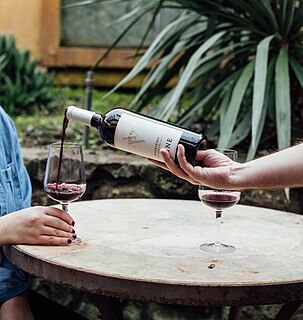
Cline Cellars Winery is a family owned and operated winery located in the Carneros wine appellation of Sonoma County, California that specializes in Zinfandels,Rhône-style wines, Chardonnay and Pinot Noir.
The Zinfandel Advocates and Producers(ZAP) is a consortium of over 200 winemakers and grape growers, as well as thousands of consumers, with the purpose of advocating, preserving, and educating about the Zinfandel grape. Started in 1991, the organizational structure of combining wine enthusiasts with wine producers served as a successful template for other wine-related organizations, such as the Rhone Rangers. ZAP is reported to be one of the largest consumer-based wine advocacy groups in the world.





















